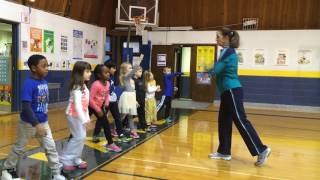

If you don’t, then you must find a way to reword the question so the students can work on it again. If you know certain students have figured out the answer, allow them to be one of the students to answer the question. After a few minutes, stop the class and allow a few students to answer. During the time the students are working on the question the teacher should walk around and work with students individually. Remember, each question should be asked to the entire class, and then allow the class to work on the question before answering the question. After a few minutes of practice, you can ask if anyone in the class knows the name of this skill! Use questions or tasks that guide the class to learning the overhand throw.

Occasionally remind the class that if it is too easy, they can move farther back. This is a good time to use your hoops clipped to a fence if you can, or propped up against the wall (if possible on top of a bench.) Do not designate how far or close they should stand. Have each student find a target on a wall, or on a bench. Get a yarn ball and then stand in front of a target so that no one else is between you and your target.Īgain start with a ball, throw at hoops or targets. Play Clean Up Your Backyard with underhand throwing. Welcome, come in and stand in an own space. PROCEDURE AND TRANSITIONS WITH MODIFICATIONS AND OR ACCOMMODATIONS Verbally describe the points to throwing underhand.Verbally describe the points to throwing overhand.Demonstrate an overhand throw, stepping with the opposite foot.Demonstrate underhand throwing to a hoop.Yarn Balls, Hoops, Pins, Targets, Control Cones, buckets Content Standard Benchmarks or Common Core Standards Learning Goals, Objectives, Expected Outcomes


 0 kommentar(er)
0 kommentar(er)
